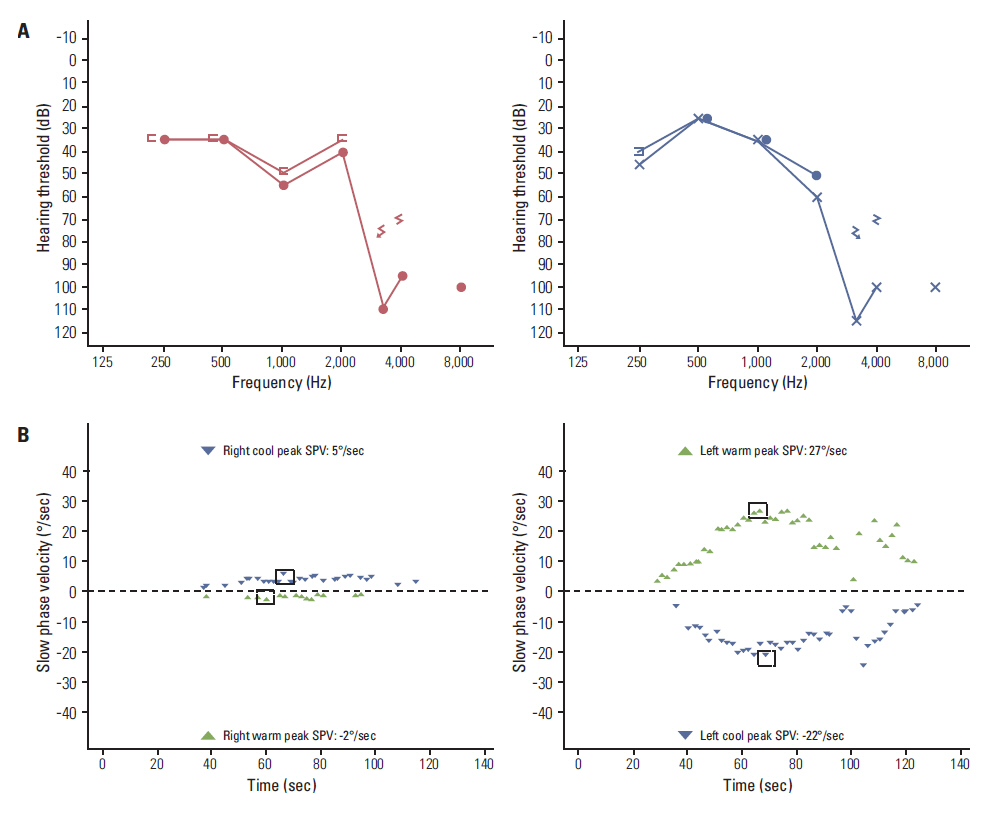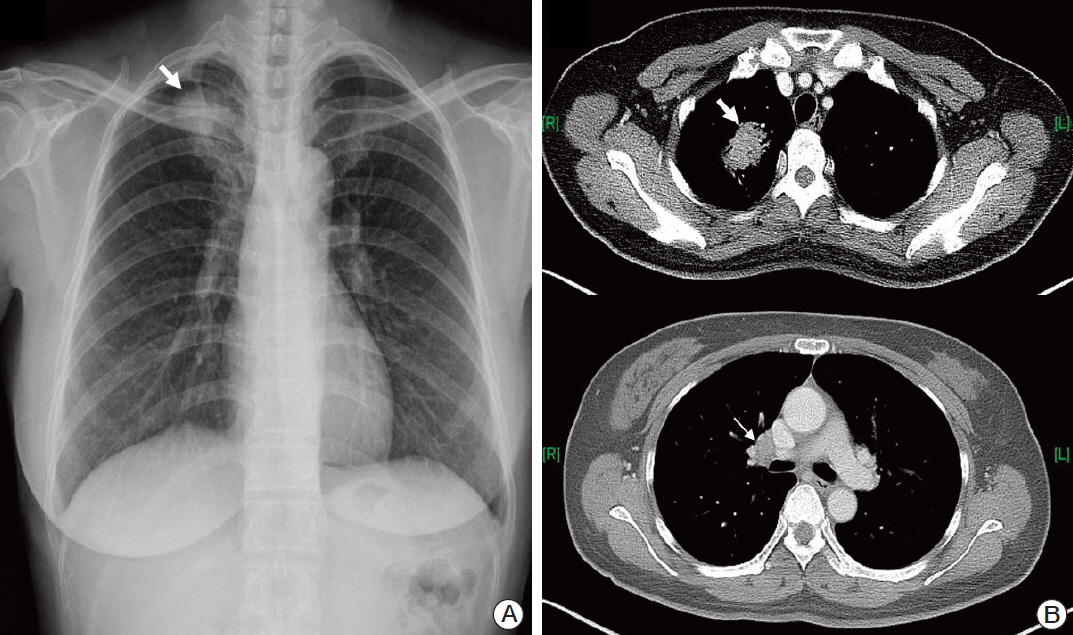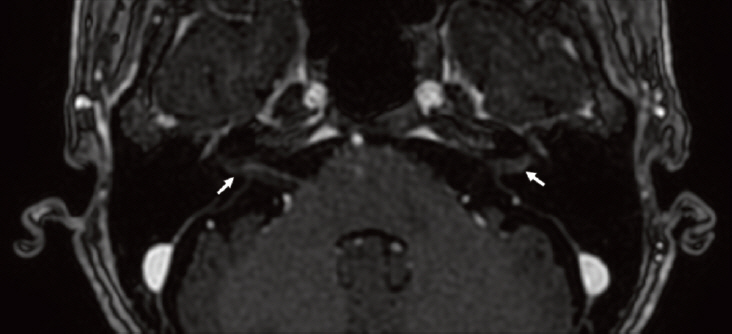Cancer Res Treat.
2015 Jan;47(1):110-114. 10.4143/crt.2013.079.
Bilateral Internal Auditory Canal Metastasis of Non-small Cell Lung Cancer
- Affiliations
-
- 1Department of Otorhinolaryngology-Head and Neck Surgery, Konkuk University Medical Center, Konkuk University School of Medicine, Seoul, Korea.
- 2Department of Internal Medicine, Konkuk University Medical Center, Konkuk University School of Medicine, Seoul, Korea. kyleemd@kuh.ac.kr
- KMID: 2380396
- DOI: http://doi.org/10.4143/crt.2013.079
Abstract
- We report on a patient with brain metastasis involving bilateral internal auditory canal from non-small cell lung cancer (NSCLC). A 49-year-old woman who had been diagnosed with NSCLC (T2aN1M0) complained of persistent vertigo and bilateral tinnitus for three months. The patient had refused all treatments, including surgery and chemotherapy; however, she sought alternative medicine. The patient's hearing loss showed rapid progression bilaterally, and rotatory vertigo with peripheral-type nystagmus developed. Magnetic resonance imaging of the brain showed irregular nodular enhancement within both internal auditory canals with leptomeningeal enhancement and multiple intracranial metastasis. The patient was treated with epidermal growth factor receptor-tyrosine kinase inhibitor, and the tumor showed partial response. This was a rare case of multiple brain metastases involving bilateral internal auditory canal from known NSCLC presenting with vertigo and hearing loss.
MeSH Terms
Figure
Reference
-
References
1. Jemal A, Siegel R, Xu J, Ward E. Cancer statistics, 2010. CA Cancer J Clin. 2010; 60:277–300.
Article2. Little AG, Gay EG, Gaspar LE, Stewart AK. National survey of non-small cell lung cancer in the United States: epidemiology, pathology and patterns of care. Lung Cancer. 2007; 57:253–60.
Article3. Sorensen JB, Hansen HH, Hansen M, Dombernowsky P. Brain metastases in adenocarcinoma of the lung: frequency, risk groups, and prognosis. J Clin Oncol. 1988; 6:1474–80.4. Chang KH, Song CE, Seo JH, Yeo SW. Solitary metastasis of bronchogenic adenocarcinoma to the internal auditory canal: a case report. J Korean Med Sci. 2009; 24:1227–9.
Article5. Schrock A, Laffers W, Bootz F. Solitary metastasis of lung carcinoma to the internal auditory canal. Am J Otolaryngol. 2006; 27:214–6.
Article6. Kang SJ, Kim KS, Ha YS, Huh SY, Lee JH, Kim JK, et al. Diagnostic value of cerebrospinal fluid level of carcinoembryonic antigen in patients with leptomeningeal carcinomatous metastasis. J Clin Neurol. 2010; 6:33–7.
Article7. Moffat DA, Saunders JE, McElveen JT Jr, McFerran DJ, Hardy DG. Unusual cerebello-pontine angle tumours. J Laryngol Otol. 1993; 107:1087–98.
Article8. Streitmann MJ, Sismanis A. Metastatic carcinoma of the temporal bone. Am J Otol. 1996; 17:780–3.9. Yoda S, Cureoglu S, Paparella MM. Pulmonary carcinoma metastasis to the internal auditory canal. Otol Neurotol. 2011; 32:e48–9.
Article10. Loo SW, Dean AF, Murray P. Internal auditory canal metastasis mimicking a vestibular schwannoma at presentation: a case report and review of the literature. Int Semin Surg Oncol. 2009; 6:8.
Article11. Krainik A, Cyna-Gorse F, Bouccara D, Cazals-Hatem D, Vilgrain V, Denys A, et al. MRI of unusual lesions in the internal auditory canal. Neuroradiology. 2001; 43:52–7.
Article12. Umemura S, Tsubouchi K, Yoshioka H, Hotta K, Takigawa N, Fujiwara K, et al. Clinical outcome in patients with leptomeningeal metastasis from non-small cell lung cancer: Okayama Lung Cancer Study Group. Lung Cancer. 2012; 77:134–9.
Article13. Heon S, Yeap BY, Britt GJ, Costa DB, Rabin MS, Jackman DM, et al. Development of central nervous system metastases in patients with advanced non-small cell lung cancer and somatic EGFR mutations treated with gefitinib or erlotinib. Clin Cancer Res. 2010; 16:5873–82.
Article
- Full Text Links
- Actions
-
Cited
- CITED
-
- Close
- Share
- Similar articles
-
- A Case of Metastatic Renal Cell Carcinoma Invasion in External Auditory Canal
- Two Cases of Cutaneous Metastasis from Small Cell Lung Cancer
- Solitary Metastasis of Bronchogenic Adenocarcinoma to the Internal Auditory Canal: A Case Report
- Ovarian Metastasis from Non-Small Cell Lung Cancer Responding to Erlotinib
- Cutaneous Metastasis from Small Cell Lung Cancer Expressing Thyroid Transcription Factor-1





